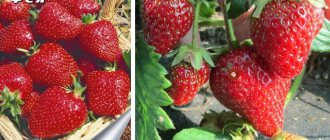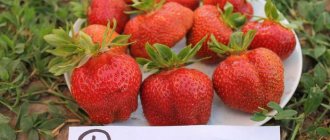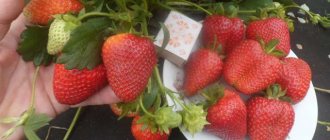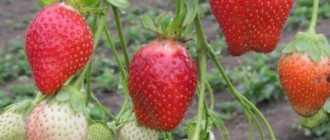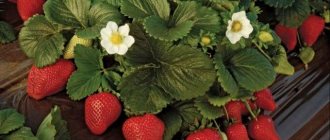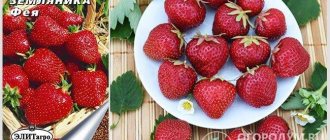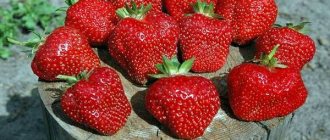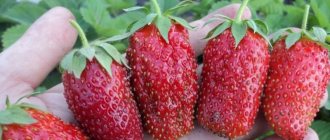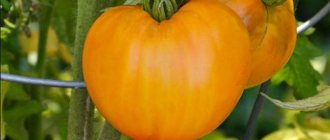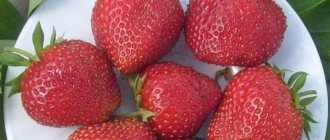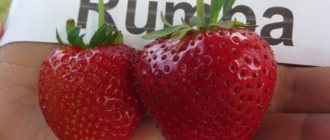Description of the strawberry variety Jolie
Getting acquainted with the Jolie strawberry variety should begin with a description. Jolie is an early ripening, high-yielding variety. From one bush you can get up to 1 kg of strawberries. Productivity depends not only on varietal characteristics, but also on climatic conditions and the region of growth.
Strawberries form a powerful, spreading bush, covered with small, slightly wrinkled leaves. The berry appears on long peduncles formed below the leaf level in early June. The bright red, conical berry weighing up to 50 g is covered with a waxy coating. The largest fruits appear at the beginning of fruiting.
The aromatic, sweet pulp is dense, which allows the harvest to be transported over long distances. It is because of this characteristic that the variety is loved by farmers, summer residents and small producers. The berry has found wide use in cooking. During heat treatment, strawberries do not become soft, remain dense, whole and do not lose their attractive appearance.
Productivity and taste are much higher when the variety is grown in the southern regions. Jolie's strawberries are not afraid of drought and heat. In extreme heat, fruiting continues only with regular watering.
Jolie strawberries, according to gardeners, can overwinter well without shelter at a temperature of -25 °C. But, despite its cold resistance, the southern variety is not recommended for growing in regions with an unstable climate, since sudden temperature changes affect fruiting and crop quality.
Frequent rains do not prevent high fruiting, since the variety has strong immunity to many diseases.
Basics of agricultural technology
“Jolie” has taken root in the summer cottages of ordinary gardeners because it has no special complaints about the conditions and care. But certain points are taken into account in order to obtain the desired harvest.
Planting and soil nutrition
It is a mistake to rely on the compactness of the bushes and plant them more densely. Five plants per meter of area is the maximum density, 40 cm between bushes is the optimal distance. Even infection-resistant strawberries will get sick: the bushes are crowded - the shoots, leaves, and berries are not ventilated.
Improper planting will ruin the plant. Read how to place seedlings in a hole so that the strawberries quickly take root and adapt.
If “Jolie” turns a blind eye to the structure of the soil, then the commercial variety is provided with nutrition in full:
- prepare a planting site charged with organic matter or mineral fertilizers;
- in the 2nd and 3rd years, feed in the spring, during flowering and fruiting, and be sure to maintain the nutritional value of the soil before winter;
The required strawberry minimum without any frills, and the Italian will generously reward you for your care.
Care
The unpretentious Jolie strawberry responds to minimal care:
- weed protection;
- loosening after watering;
- mustache trimming from spring to autumn;
- treatment of bushes at the beginning and end of the season.
The drought resistance of garden strawberries of Italian origin will please gardeners and farmers from regions with a climate that is stingy with rain. But you shouldn’t test the variety’s patience. The characteristic suggests that summer residents who go to their plots only on weekends will not be left without a harvest.
Gardeners can be helped by mulching with straw, peat or planting on agrotextiles. The technology protects against moisture loss and weed dominance.
About caring for strawberries in the summer - video from an experienced gardener:
According to reviews, the taste of the berries does not deteriorate due to changes in humidity. But Jolie doesn’t like dampness. Therefore, in areas with high groundwater, the beds are raised or drainage is provided when preparing the site for the plantation.
Reproduction and rejuvenation
Initially, strawberries appear in the beds as seedlings or seedlings using frigo technology. Industrialists grow the variety for a couple of years, and private owners renew the plantations after 4 years.
The vitality of the variety is confirmed by experience: rosettes with a developed root system quickly grow. The first berries are harvested from bushes planted in spring in the summer. But more often strawberries are planted at the end of summer.
For reproduction, 2 methods are used:
- select the mother bed to remove flower stalks, obtaining strong rosettes;
- From a flowering and fruiting bed, take the first strong tendril with a rosette, removing the remaining shoots.
Pros and cons of the Jolie variety
Like any variety, Jolie strawberries have a large number of positive qualities. These include:
- high productivity;
- early ripeness;
- large fruits of high quality;
- immunity to diseases and drought resistance;
- good transportability and long shelf life;
- ease of reproduction and good survival rate.
The disadvantages many summer residents include:
- productivity decreases with sudden changes in temperature;
- low location of the peduncle, the ripe berry comes into contact with the ground, which can lead to rot;
- When grown on infertile soils, the taste is significantly reduced.
Varietal features
The variety is positioned as an industrial variety - for cultivation in large and medium-sized farms. Therefore, first of all, evaluate:
- Marketability is the highest score, since almost 100% of the harvest is fruit of the 1st quality class.
- Keeping quality - without refrigeration, it is stored for 4-5 days, without leaking juice, without deformation.
- Transportability - berries arranged in boxes can be easily transported, maintaining their ideal appearance (see photo).
- Taste - 4.7 - only 0.3 points is not enough to dislodge the leaders.
- Productivity is 600-800 g, but having invested in care and feeding, you get 0.9 kg. “Jolie” overcomes the 1000 g mark in exceptionally favorable conditions.
Italian is classified as a mid-early variety. The type of fruiting is not remontant, but the harvest takes 3-4 weeks. The berries, aligned by caliber, weigh 20-35 g.
Planting and caring for Jolie strawberries
To grow a large, high-quality harvest, it is necessary to follow agrotechnical rules. Caring for Jolie strawberries is no different from growing varieties of French and Italian selection.
Selection and preparation of a landing site
The planting site should be protected from drafts and located on the sunny side. Jolie strawberry grows and develops poorly in wet soil, so if the groundwater is shallow, the seedlings are planted in high beds. The soil must be fertile and neutral acidity.
Jolie strawberries grow well after garlic, carrots, herbs, legumes, bulbs and cruciferous crops. It is not recommended to plant berries after nightshade, pumpkin and sunflower crops. Strawberries of the Jolie variety have strong immunity to diseases, but from slugs they can lose a large number of leaves and ripened crops. To ensure that pests avoid strawberry bushes, it is necessary to plant onions, garlic, beets or radishes nearby.
Strawberries are unpretentious to soil quality, but grow poorly in acidic soil. If the soil is acidified, then dolomite flour or slaked lime is added when digging. Strawberry bushes grow in one place for about 4 years, so before planting you need to prepare nutritious soil. If the seedlings are planted in the spring, the ground is prepared in the fall. To do this, dig up the earth onto the bayonet of a shovel and 1 square meter. m contribute:
- manure – 5-6 kg;
- superphosphate – 50 g;
- potassium chloride – 15 g;
- Ammonium sulfate – 25 g.
Advice!
You can replace the listed minerals with complex mineral supplements. Strawberry beds can be made in several ways:
- Low mound - suitable for dry, well-drained areas. The beds are formed in the shape of a trapezoid, which does not allow the soil to crumble around the edges.
- High - such beds are made in areas with high groundwater levels. High bases are easy to maintain and look attractive.
- Under agrofibre is a new method that has gained great popularity. A covered bed warms the soil, prevents the berries from coming into contact with the ground, and prevents weeds from sprouting. The breathable fiber acts as mulch.
- Decorative vertical and horizontal beds save space and add a special “zest” to the landscape design.
Preparation of planting material
A rich harvest depends on correctly selected and prepared seedlings. It is better to purchase young bushes from nurseries or trusted suppliers. Before purchasing, you must carefully inspect the seedling. The strawberry bush must meet certain requirements:
- leaf plate without mechanical damage and signs of disease;
- in a high-quality seedling, the rosette consists of well-developed foliage;
- the core is healthy and bright green;
- the root collar is powerful and well developed;
- root system 8-10 cm long, without visible damage.
The purchased seedlings must be shed generously with warm, settled water 1.5-2 hours before planting. Next, immediately before planting, the plant is removed from the container and soaked for 1 hour in a growth stimulator, herbal starter or garlic solution. If the roots of the seedlings have grown more than 10 cm, they are shortened with a sterile, sharp instrument before planting.
Landing rules
Jolie strawberries can be planted in spring, summer and fall. If you plant a variety in the spring, you won’t get a good harvest in the year of planting. In order for strawberries to begin actively bearing fruit next year, planting is done in the summer. Bushes grown from rooted tendrils are planted in the fall.
There are several ways to plant Jolie strawberries:
- individual bushes;
- into the ranks;
- nests;
- carpet method.
When planting strawberries in separate bushes, it is necessary to maintain an interval between plants of at least 60 cm. To prevent the planting from thickening over time, it is necessary to remove the tendrils in a timely manner. The advantages of the method include: ripening of a large harvest, low probability of diseases.
When planting in rows, the distance between bushes is 20 cm, between rows 70 cm. When planting in this way, it is necessary to constantly loosen the soil and remove weeds.
Advice! You can get rid of weeds with a 15 cm layer of mulch or by covering the bed with black agrofibre.
The nesting method allows you to get a large harvest. Plants are planted according to a certain pattern: 1 bush is planted in the center, and around it 6 more bushes at a distance of 8 cm so as to form a hexagon. The interval between nests is 30 cm, between rows - half a meter. The disadvantage of this method is a large amount of planting material.
The carpet method is the easiest way to grow Jolie strawberries. The essence of the method is that the tendrils of the bushes are not removed, thereby forming a living carpet that will retain moisture and stop the growth of weeds. This method is suitable for those summer residents who cannot frequently water and loosen the soil.
Important! When planting a seedling, you should not bury the core. If this rule is not followed, the core will rot, which will lead to the death of the plant.
After planting the seedling, the top layer is compacted, watered and mulched. Mulch will retain moisture, stop the growth of weeds and act as an additional organic fertilizer. Sawdust, mowed grass or hay are used as mulch.
Watering and fertilizing
Since the plant grows in one place for 4 years, it is necessary to provide timely fertilizing annually. Without fertilization, the land will quickly deplete, which will affect the quality and quantity of the harvest.
In the first year of cultivation, if the bed has been well fertilized, do not feed the strawberries. Next, fertilizers are applied 4 times per season:
- In spring, ash is added under each bush. Infertile soil is fed with rotted manure or humus.
- During the formation of buds, organic fertilizer is used.
- After harvesting the first crop, complex mineral fertilizers are used.
- At the end of September, after removing old, damaged leaves, fertilizing is carried out with phosphorus-potassium fertilizers.
Strawberry Jolie is a drought-resistant variety. But for good fruiting, the bushes require regular watering in June, when leaves, flowers and fruits appear simultaneously. Watering is carried out using the trench method. Strawberries are not irrigated at the root level, since the root system is spreading, and the main roots are located along the periphery of the above-ground part of the plant.
After harvesting, watering is carried out every 2-3 days. If the weather is dry, irrigation is necessary daily.
In autumn, winter watering is done to preserve the root system. To do this, the bush is shed to a depth of 30 cm.
Mulching and loosening
Strawberry Jolie loves light, loose, breathable soil. Therefore, after each watering, in order to prevent the appearance of an earthen crust, it is necessary to carry out careful loosening.
Before flowering begins, hilling is carried out 3 times a week, during the harvest period - once every 14 days. The soil is cultivated to a depth of 4 cm.
To maintain moisture, get rid of weeds and protect the root system from sunburn, it is necessary to mulch the soil. To do this, the bed can be covered with black cloth, a 15 cm layer of straw, mowed grass or sawdust.
Preparing for winter
Despite the fact that Jolie strawberries can overwinter well at -25 ° C, it is better to prepare them for winter. For this:
- the earth is shed abundantly;
- fertilize with phosphorus-potassium fertilizers;
- the ground is mulched with straw, fallen leaves or pine needles.
Review
Valentina Pavlovna
I saw strawberries of the Jolie variety on a neighbor’s plot, I liked the tall bushes with beautiful glossy berries. I purchased seedlings in cassettes - they are very easy to transplant to the site. Before planting, I fertilized the soil with humus, since our soil is poor. The strawberries began to bear fruit the following summer (I planted them last fall), although there were very few berries. But after another year, we managed to collect about 800 grams from each bush. For me, the advantages of the variety were its productivity, unpretentiousness to the composition of the soil and the attractive appearance of tasty berries. Among the minuses, I can note the dependence of the yield on the amount of fertilizing and the infection of bushes with rot in rainy summers. Despite everything, in three years Jolie multiplied her mustache by about 3-4 times.
Harvesting
Since Jolie strawberries are an early ripening variety, the first harvest is harvested in mid-June, when the berry turns red on 2/3 of its surface. Since the yield lasts for 3 weeks, the ripening of the berries occurs gradually, the berries are collected once every 4 days.
Properties of berries:
- Collected unripe berries quickly ripen during transportation and storage, but they will be less juicy and sweet.
- The taste of the Jolie variety is revealed only at full ripeness. To appreciate the taste of strawberries, you need to take your time with harvesting. Fully ripe berries are left on the bush for another 2-3 days. Such fruits are unsuitable for long-term storage and transportation, but they fully reveal the varietal bouquet of taste and aroma.
- To increase fruiting, the crop is not harvested at full maturity, since the ripening process stops the growth of the ovaries.
Growing garden strawberries
To grow a full-fledged harvest, you need not only to properly care for the crop, but also to plant the seedlings correctly.
Garden strawberry seedlings are planted in spring, summer and autumn. It is best to carry out planting work in late summer and early autumn, since with such planting the harvest can be obtained already in the next season. If you plant strawberries in the spring, the harvest can only be obtained in the next season.
Before starting planting work, it is necessary to prepare the site. This is done 2-3 weeks before the planned planting. The area is cleared of weeds and loosened (it needs to be dug up to a depth of at least 20 cm). It is also advisable to fertilize the soil with organic matter.
The landing diagram itself looks like this:
- First of all, holes are dug in a pre-prepared area. The depth of the holes must be at least 15 cm.
- The distance between the holes is at least 30 cm so that the plants do not cluster too much. Row spacing should be about 60-70 cm. Such a large distance will allow you to care for the crop without problems and easily harvest.
- After the holes are dug, they are well watered.
- When the water is absorbed, a seedling is placed in the hole. Then sprinkle the bush with soil and compact it slightly.
- At the end of all work, each bush is watered with water (approximately 1 liter per plant).
Tomato Siberian Troika: variety description, photos, reviews
Diseases and pests
Strawberry Jolie has strong immunity to diseases. But if agrotechnical rules are not followed, Jolie strawberries, according to gardeners, can be affected by:
- Strawberry whitefly - the pest can be recognized by curled leaves with yellow spots and biological secretions in the form of granulated sugar. To combat the pest, the bush is treated with insecticides three times with a weekly interval.
- Strawberry leaf beetle - affects leaves and berries. Without treatment, it leads to drying out and death of the plant. The bush is treated with insecticides before flowering and after harvesting.
- Nematodes are a dangerous pest that can lead to the death of a bush. The disease can be recognized by a stop in growth and development, deformation of foliage and peduncles, and lack of fruiting. Heavily infected plants are treated with Fitoverm.
- Aphids are microscopic pests that settle on petioles, leaves and peduncles. The insect can be identified by the deformation and drying of the leaf plate, the formation of a sticky mass on the plant, and the cessation of bud formation.
Reproduction
During the first year after planting, young strawberry bushes produce 2–5 healthy runners, which are good planting material. For propagation, several of the strongest specimens are rooted, the rest are removed.
You can root the mustache directly into the ground or into a plastic container. At the end of summer, the resulting rosettes can be separated from the mother plants and planted in a permanent place.
